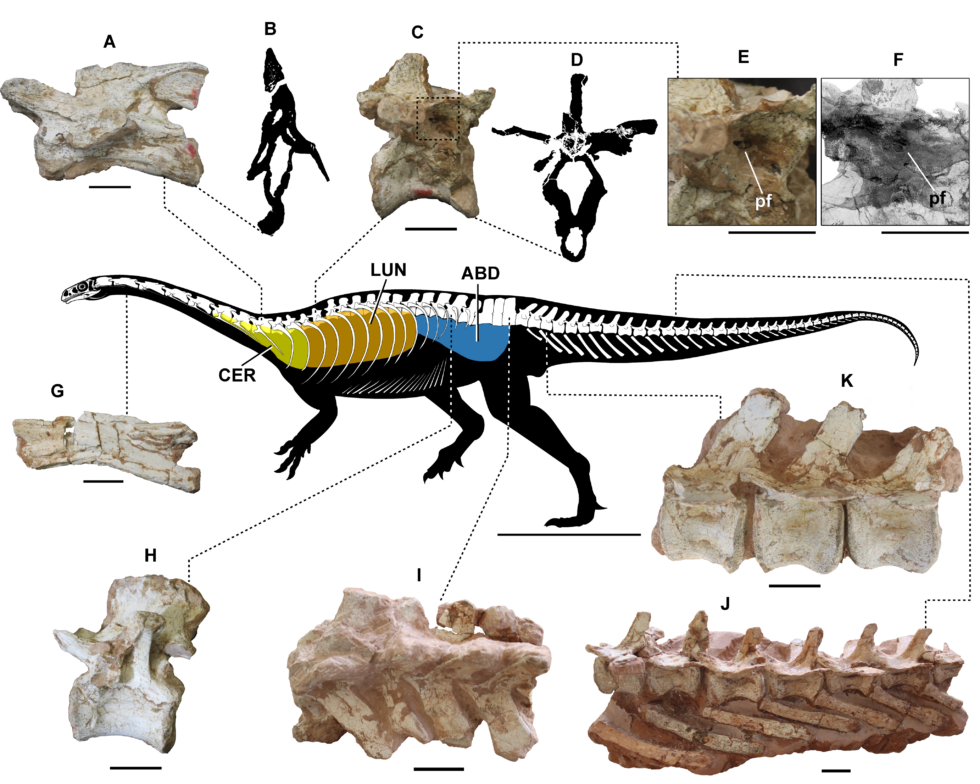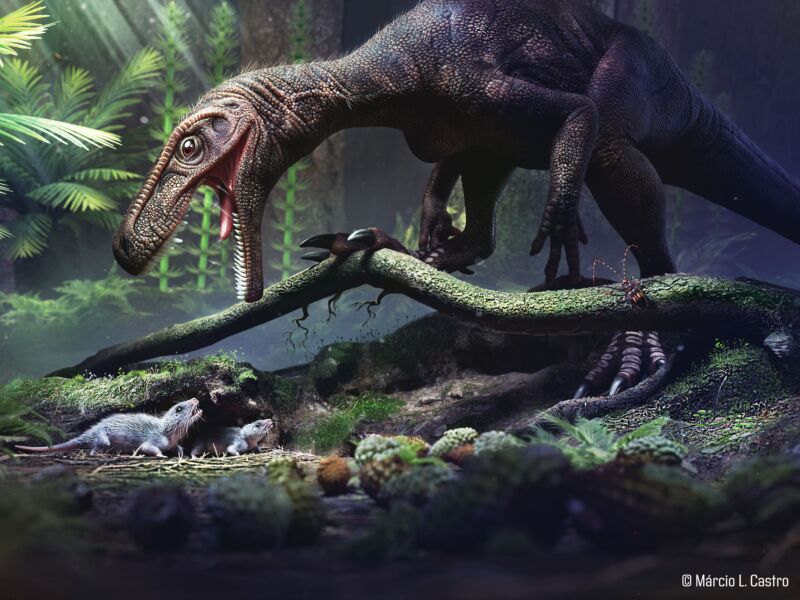Somewhere in Earth’s past, some branches on the tree of life adopted a body plan that made breathing and cooling down considerably more efficient than how mammalian bodies like ours do it. This development might not seem like much on the surface, until you consider that it may have ultimately enabled some of the largest dinosaurs this planet has ever known. It was so successful that it was maintained by three different groups of extinct species and continues to exist today in the living descendants of dinosaurs.
Because lungs don’t usually survive fossilization, one might wonder how scientists are able to ascertain anything about the breathing capabilities of extinct species. The answer lies within their bones.
In a suite of papers published in late 2022 and early 2023, paleontologists examined fossil microstructure within some of the earliest known dinosaurs to determine just how early parts of this system evolved.
Breathing efficiency
In species like birds, that system contains cavities, also known as “air sacs,” within bones located throughout the entire body. Unlike mammalian breathing, where inhaling and exhaling are two separate processes, these bones help enable unidirectional breathing: inhaling and exhaling at the same time. Known as postcranial skeletal pneumaticity, it’s part of an extraordinarily efficient system that rapidly gets oxygen into the blood and extracts heat from the body.
Today, that invasive air-sac system is known only in birds. Birds and crocodilians are archosaurs, the living relatives of non-avian dinosaurs and pterosaurs. While today’s crocodilians have unidirectional breathing through their lungs, their air handling does not extend to their bones, which do not have any air-sac cavities. A 2012 PLOS One paper examined air-sac systems in the Triassic, and the authors determined that “no crocodile-line archosaur (pseudosuchian) exhibits evidence for unambiguous” postcranial skeletal pneumaticity.
“There are no anatomical signs of any true pneumatic features that would have been related to invasive air sacs prior to the evolution of pterosaurs and saurischian dinosaurs,” Tito Aureliano, who was not part of that PLOS One research, explained of the authors’ conclusion.
Aureliano, a paleontologist at Brazil’s Universidade Federal do Rio Grande do Norte, is lead author on the three more recent papers. He explained that, as mammals, we can become breathless or overheated through intense physical activity or intense heat. Not so if you have an invasive air sac system.
When did these air sacs evolve? They’re already present from approximately 145 to 66 million years ago within Cretaceous theropods (bipedal dinosaurs that were either carnivorous or herbivorous), pterosaurs (flying reptiles), and sauropods (gigantic long-necked dinosaurs).

Thus, to find their origin, the team looked further back to the Triassic (about 252 to 201 million years ago). They studied two types of sauropodomorphs (early sauropods before they evolved long necks and enormous size) named Buriolestes and Pampadromaeus, and a type of carnivorous dinosaur known as Gnathovorax. (Whether Gnathovorax is a theropod or a herrerasaurid—a different type of dinosaur—is currently debated.)
“So the big question was,” Aureliano said in a video interview, “did the common ancestor of these three groups back there in the Triassic already have air sacs or did the air sacs originate three times independently in evolution?”
Multiple origins
Traces on fossil bone tissue matching those seen in extant birds—today’s dinosaurs—would indicate the presence of this respiratory adaptation. None of the early species contained these traces, indicating that postcranial skeletal pneumaticity hadn’t yet evolved. This means it couldn’t have been present in the common ancestor of the dinosaurs and other major groups where it was also present.
This surprised co-author Aline Ghilardi, a paleontologist and tenured assistant professor, also at Brazil’s Universidade Federal do Rio Grande do Norte. “Since the earliest dinosaurs didn’t have the invasive pneumatic structure,” she said, “[the air sacs] had to have evolved after that. And if it evolved after that, logically, pterosaurs had to have evolved it in a parallel way.”

In other words, these results suggest that three lineages of extinct species evolved the same respiratory system independently. This phenomenon is known as convergent evolution.
But the fossils also suggested that the evolution of air sacs had started by this time. Aureliano explained that the two sauropodomorphs and the one herrerasaurid they studied lived approximately 233 million years ago, but Pampadromaeus “was collected in a bedrock that was a little bit higher,” meaning that it existed a little later in time than Buriolestes. That gap in time, although relatively small geologically speaking, presented “a huge change” in the sauropodomorph skeleton. Pampadromaeus had a new kind of tissue that the team suspects may have been a step toward the evolution of air sacs.
“The whole vasculature was different [in Pampadromaeus],” Aureliano said. “It was less dense and [had] fractals inside, very small chambers to receive blood and fat tissues.” This, he added, would make it “easier in the future for the invasive air sacs to occupy” the space created by those fractals, “because air sacs work like fractals going out of the lungs.”



3175x175(CURRENT).thumb.jpg.b05acc060982b36f5891ba728e6d953c.jpg)

Recommended Comments
There are no comments to display.
Join the conversation
You can post now and register later. If you have an account, sign in now to post with your account.
Note: Your post will require moderator approval before it will be visible.